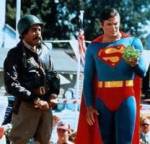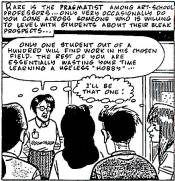| |
 |
| Tom Spurgeon's
Web site of comics news, reviews, interviews and commentary |
 |
|
 |
 |
|
 |



May 11, 2010
 CR Readers Are Very Smart Readers
CR Readers Are Very Smart Readers

The esteemed Charles Hatfield sent the following commentary on yesterday's post about superhero movies. Good commentary on the Seitz piece, Tom, and Seitz himself is pretty good too (though I'm flummoxed by his praise for Superman Returns as original and daring; I thought that movie had a damp fuse).
I'm teaching a superheroes course this fall for the first time, a cultural studies seminar in which we'll talk about superhero comic books and also movies, so this discussion holds a lot of interest for me.
It seems to me that the big-budget superhero movie is an even more sorely constrained genre than the superhero comic book, if only because superhero movie have to shoot the moon every damn time. There's a difference in narrative structure that stems from differences in the means of delivery. Whereas monthly comic books, even in this aim-for-the-TPB era, can exhibit some flexibility in their narrative structure and pacing -- a single issue can be just that, or it can be part of some anticipated multi-issue saga -- a big-budget, big-tent superhero movie must almost always do similar things and rev up to a similar sort of climax. So you can't build a mainstream superhero movie around a one-off character study or comical interlude, or a mundane heist story with ironic flavoring, or a soap-opera like resolution of long-simmering subplots. You can't focus the movie on a sidelong story that provides relief from the sturm und drang. Instead you have to go for broke all the time.
 This is not only because the narrative structuring of a (nominally) self-contained movie is supposed to be different from a serial that comes out at quick intervals. It's also because of the huge costs associated with the genre. The elements that tag superhero films as a genre are super-expensive: big, above-the-line costs for talent (name actors, mainly); big design challenges; lots of visual effects and elaborately choreographed action. The logic that governs the production of such films as Risk Big to Win Big; usually producers aim to slather on more and more stuff, rather than dial back the excess. There's a certain Barnumesque hubris involved (can you top this? etc.) but also a need to provide novelty in a film-making era saturated by digital excess. And, let's face it, if you're paying seven figures or more to line up your lead actors, you're not going to make a kitchen sink drama. Instead you're going to leverage a boatload of money and try to out-spectacle the next guy. This is not only because the narrative structuring of a (nominally) self-contained movie is supposed to be different from a serial that comes out at quick intervals. It's also because of the huge costs associated with the genre. The elements that tag superhero films as a genre are super-expensive: big, above-the-line costs for talent (name actors, mainly); big design challenges; lots of visual effects and elaborately choreographed action. The logic that governs the production of such films as Risk Big to Win Big; usually producers aim to slather on more and more stuff, rather than dial back the excess. There's a certain Barnumesque hubris involved (can you top this? etc.) but also a need to provide novelty in a film-making era saturated by digital excess. And, let's face it, if you're paying seven figures or more to line up your lead actors, you're not going to make a kitchen sink drama. Instead you're going to leverage a boatload of money and try to out-spectacle the next guy.
There’s a logical of massification here that results in sequels getting bigger and bigger. Another way to put this would be that the movies often suffer from a kind of narrative priapism.
Combine this with the actors' desire to do something "challenging" with the roles and the audience's desire to see the actors put through their paces, and you can see what a challenge the genre becomes: a spectacular circus of a movie that nonetheless must give its (obscenely well paid) actors something to do. Also important here is some sort of dyadic romance plot, because (a) romance, thank goodness, tends to leaven the brute qualities of the genre and widen its appeal; and (b) movies that draw in repeat business from girls and women and couples do better on the long term than movies that don't (as James Cameron seems to understand).
From this, we could probably put together a list of expected elements in blockbuster superhero movies, elements that are deemed essential for the multiplex but are not necessarily to be expected in superhero comics each time out:
1. There will be romance. A couple's story will be an important under-girding element of the plot. Nolan et al's Batman films get about as close to downplaying this element as blockbuster costume movies can, but of course it's still there.
2. There will be some "personal" stake in the plot for the hero. That is, the plot will foreground some psychological or moral dilemma for, or some mortal danger to, the title character. This is not always the case in superhero comics, where a hero can foil a villain's plot without having a vested personal interest. Witness how Spider-Man's origin story was "ret-conned" in Raimi et al's Spider-Man 3 so that Peter Parker could become more personally invested in taking down the Sandman. This gives the lead actor something to do and sharpens the stakes considerably.
3. The danger posed by the villain(s) will, in the end, be near-apocalyptic in scope. The entire city if not country or world will be threatened, so as to justify pulling out all the stops, action and effects-wise. This is true even of The Dark Knight, whose most frightening moments involve being up close and personal with Ledger's Joker. IMO the out-sized car chases and stuntwork in that movie have a tacked-on quality that vitiates the drama of the Joker story, which plays out most effectively in close-up. (The filmmakers, though, lean hard on the idea of the Joker as terrorist, in order to justify ratcheting up the damage and spectacle.)
4. The casting of villain(s) will usually be very important, and parallels between hero and villain (what once seemed fresh in the hands of Alan Moore or Frank Miller) will often be underlined. In many cases heroes and villains will have paired origins or at least shared roots, as in the first Nolan (or, for that matter, Burton) Batman. Villain roles will be plum roles and will provide much of the interest in sequels. Casting in general will be monitored by fans with a mixture of anxiety and enthusiasm.
The above elements sometimes but not always appear in serial superhero comics. They are typical of superhero movies. This is why, I think, the degree of variation in superhero films is sorely limited. What you have with this genre is a set of expectations that in its specificity and demands rivals that of the James Bond franchise. In other words, superhero movies in general, whichever the hero, are as hemmed in and constrained as Bond films. So there's very little leeway in terms of development.
This is not simply because they're about superheroes; it's because they're blockbuster films with huge budgets rather than chapters in a serial that comes out in regular installments like a comic book monthly (or a weekly TV show). The different narrative demands of feature films, and the logic of Risk Big to Win Big, force what was a serial genre into a new kind of straitjacket. *****
Jim Ottaviani made the following objection to part of Friday's Brian Hibbs interview: When talking about why it's easier for artists to support the CBLDF with a donation of their work than it is for retailers with a donation of money, Brian said: "I don't want to say this takes no effort or no money out of their pocket. But it takes less than money to a certain extent, because you're using your god-given talent rather than opening your wallet and taking money and putting it on the table."
 I'm not sure what he didn't want to say, because what he did say sounds shortsighted and foolish, and surprising coming from someone who called other retailers shortsighted and foolish just two sentences prior to the one quoted above. Talent may be god-given, but the actual skill that makes an artist's work a salable commodity for the CBLDF -- or anyone else -- is paid for with time and effort. The time an artist spent getting to the point where the CBLDF would actually want a sketch, and the time spent on the sketch itself, is worth a great deal, and more than most artists charge. I'm not sure what he didn't want to say, because what he did say sounds shortsighted and foolish, and surprising coming from someone who called other retailers shortsighted and foolish just two sentences prior to the one quoted above. Talent may be god-given, but the actual skill that makes an artist's work a salable commodity for the CBLDF -- or anyone else -- is paid for with time and effort. The time an artist spent getting to the point where the CBLDF would actually want a sketch, and the time spent on the sketch itself, is worth a great deal, and more than most artists charge.
Other than that, I thought this was a great interview, and I appreciated reading both your and Brian's thoughts. Thank you, Charles and Jim.
posted 9:00 am PST | Permalink
Daily Blog Archives
November 2019
October 2019
September 2019
August 2019
July 2019
Full Archives

|
|
 |
|
 |
 |
|
|

